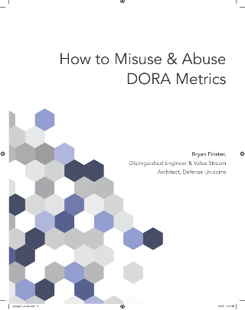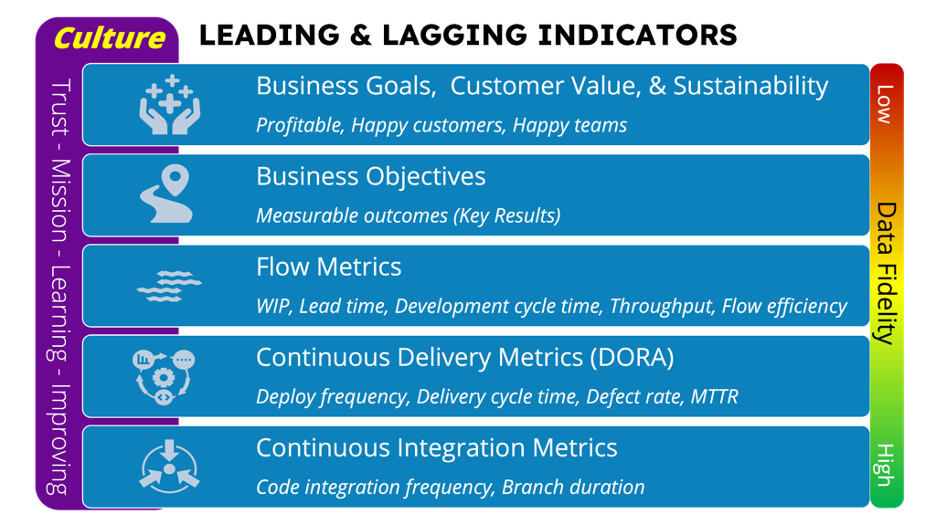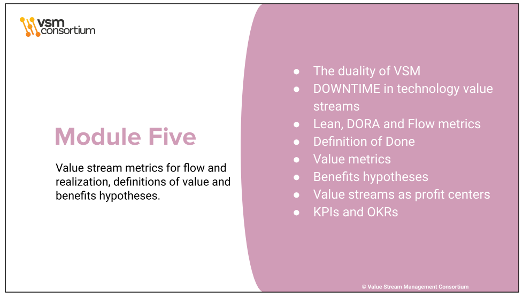In this post, we’ll discuss DORA metrics, flow metrics, value stream improvement, and how they relate to each other.
I have been a software engineer for nearly three decades. About ten years ago, I accidentally fell into the role of improving value streams, though I didn’t know that then. The first value stream map I ever saw was one done by consultants that showed it took us twelve months from the time we received a request from the business to deliver it. To improve our ability to deliver to the business, we decided to learn how continuous delivery worked. During that process, we improved the value stream from the inside out.
After realigning from project teams to product teams, we began solving the mysteries of moving from delivering every quarter to delivering every day. Since years of Scrum training and SAFe didn’t improve our outcomes, we started with some simple concepts.
- Embrace the suck: As Jez Humble says, “If it hurts, do it more.” We took that seriously and applied it as a rule.
- Simplicity: we will start with no process and only add processes that make it easier to deliver.
- Continuous improvement: Ask, “Why can’t we deliver today’s work to the end user today?” and then fix the next problem every day until we can.
Armed with our new “Agile framework,” we began our journey. The details of that are too in-depth for this article. I gave a talk about it at QCon NYC 2023, which should be online very soon for those who are interested. However, the lessons learned were very valuable and relate directly to why DORA metrics can, if used properly, be helpful. Several years after this experience, DORA metrics were introduced in “Accelerate” to make correlations between CD behaviors and organization performance. When they were published, the correlations resonated with our experience.
|
DORA Metrics:
|
What did we discover?
- Driving down batch size was the most effective method we’d ever found to uncover and remove waste and pain. This applied to everything from how frequently we committed code to how big features were. You can read more about that journey on my blog.
- When a team clears its internal flow constraints, it makes the drag from external constraints glaringly obvious. It is obvious that it can begin to exert pressure on the organization to improve those instead of telling the team, “Work faster.”
DORA metrics can help us understand how our efforts to remove waste and pain are progressing. By showing how batch size is changing over time (deployment frequency) while also tracking the rate of defect creation over time (change fail rate), we have a high-level view of whether things are getting better or worse with a set of balanced metrics. To be clear, those are like the “check engine” light in your car. They tell you something is wrong, but that doesn’t tell you what, and having “good DORA metrics” is like not having the check engine light on. It doesn’t mean your engine is fine.
I wrote a paper for IT Revolution called How to Misuse and Abuse DORA Metrics that does a deeper dive into the topic, including useful lower-level metrics.

How does this relate to value stream management?
You cannot improve a software value stream without taking a hard look at the things impacting the efficiency of product teams. Any team using any method can deliver once per month. There’s no need for any defined process at all. Waterfall, Scrum, XP, etc don’t matter when delivering monthly. The waste remains hidden. We could do a value stream map of the overall flow, but the real problems will still be elusive. By improving our batch size and delivered quality along with things like how often we integrate code and how fast teams can get feedback on quality, Doing that exposes the garbage we’ve had hiding under our rugs.
All of the metrics have a dependency relationship. CI is a leading indicator for DORA, which is a leading indicator for flow, and so on.

Measurable Goals to Help Drive Improvement
(This image is provided under a creative commons license:CC BY 4.0 - Bryan Finster - Commercial use with attribution)
Taking continuous delivery seriously is the engine that drives value stream improvement. Improving the efficiency of the value stream lowers the cost of trying new things and improves the speed at which we can find out how much an idea needs to be improved. Then, all that’s left is to have better ideas.
We assembled a set of problems to solve and some help solving them at MinimumCD.org because discovering these was hard, and we want to help people find good information more easily. Try CD. Take it seriously. If it hurts, do it more often. Your value streams will improve.
On the same subject, don't hesitate to consult our previous posts:
- Value Stream Metrics: If You Don’t Know Where You Are, How Do You Know Where to Go?
- Data-Driven Value Stream Management: Time to Get Your Transformation Right
See also our research and learning from here:
- State of Value Stream Management Reports
- VSM Foundation Course and its Module Five on “Value Stream Metrics”

DevOps Research and Assessment (DORA) is a research program run by Google Cloud.
Picture Credits: Shutterstock

Bryan Finster
I’m a passionate advocate for continuous delivery with over two decades of experience building and operating mission-critical systems for very large enterprises. I understand from experience that solving the problems required to continuously deliver value improves outcomes for the end-users, the organization, and the people doing the work. I currently work for Defense Unicorns helping to solve some of the hardest software supply chain problems. I’m one of the maintainers of MinimumCD.org and DojoConsortium.org, the author of several papers on improving software delivery flow, a board advisor for the VSMC, and a Distinguished Engineer for Defense Unicorns.








Comments 2